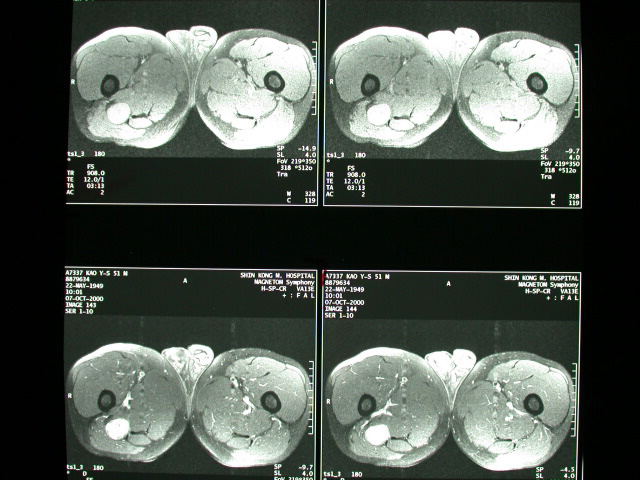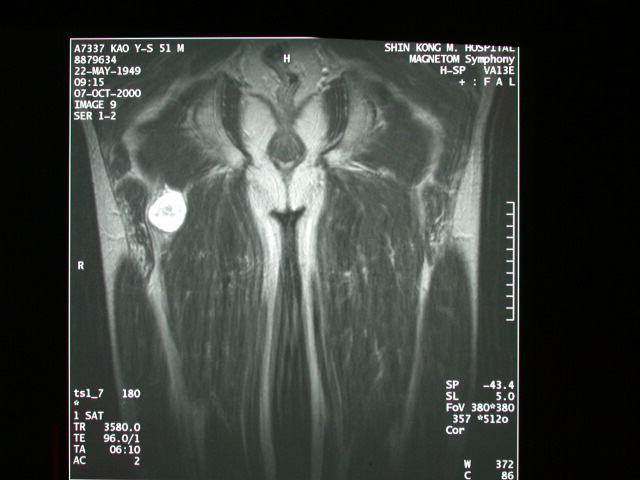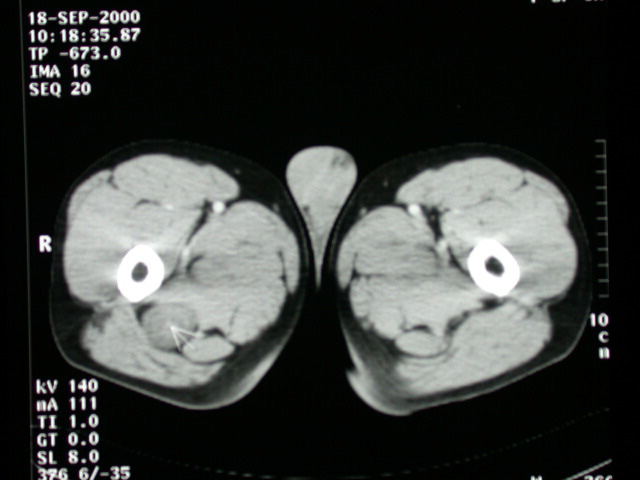History:
A 51 y/o male suffered from a palpable mass over the right buttock
over a period of time.
Questions:
1. What are the findings?
2. What is the differential diagnosis?
3. What is the diagnosis?
Answers:
1. CT of bilateral upper thighs with/without contrast:
l A well-defined round soft tissue mass (about 3x3x3 cm) at posterior
muscular group of the right upper thigh.
l It locates between biceps femoris, semimenbranosus /semitendinosus
and adductor magnus with close relationship to the neurovascular
bundle. The adjacent muscles appear displaced around the lesion.
l It is hypodense to the muscle in the presontrast scan and shows
moderate enhancement after contrast adminstration.
MRI of the bilateral upper thighs with/without contrast:
l A well-encapsulated mass lesion at posterior muscular group of
the right upper thigh between biceps femoris, semimenbranosus /semitendinosus
and adductor magnus with close relationship to the neurovascular
bundle.
l It is of iso- to slightly hyperintense SI on T1WI as muscle and
heterogenous hyperintense SI on T2WI. The lesion has central regions
of low signal intensity.
l Marked enhancement of the lesion is evident.
2. Schwannoma, Neurofibroma, Neuroepithelioma, Ependymoma, Soft
tissue sarcoma, Myxoma.
3. Schwannoma
Discussion :
The imaging findings in this case are fairly nonspecific, and both
benign and malignant soft tissue masses must be considered. Both
malignant and benign soft tissue tumors tend to have a well-encapsulated
appearance. Soft tissue sarcomas tend to be quite large at the time
of presentation, and when they are heterogeneous on MR imaging,
the central portion tends to have high intensity (from liquefactive
necrosis) rather than the periphery.
Benign tumors of nerves include neurofibroma and neurilemoma. The
most common malignant nerve sheath tumor is the schwanoma; less
common lesions included a neuroepithelioma and a soft tissue ependymoma.
Schwannomas and neurofibromas occur in all age group , but more
common between the ages of 20 and 50 years. The sites most commonly
involved included the trunk and the proximal extremities. They favor
the flexor compartments (along the large nerves) when present in
the extremities. Schwannomas grow slowly and are freely movable,
but not along the axis of the nerve from which they arise. Most
schwanomas and neurofibromas show a slightly heterogeneous distribution
of intermediate signal intensity on the T1-weighted images and,
typically a very high signal intensity on the T2-weighted images,
occasionally quite heterogeneous distributed. The heterogeneity
may be attributable to hypocellular or hypercelluar areas as well
as to necrotic and fibrotic areas. MRI often delineate a low-signal
capsule. Schwannomas are typically round or ovoid in outline and
tend to occur in the subcutneous tissue with indentation of adjacent
muscles or neighboring large narves. MRI can not reliably distinguish
a malignant nerve sheath tumor from its benign couneterpart.
In many cases of benign neurofibroma and schwannoma the lesions
exhibit a characteristic "target" appearance on T2-weighted
images with a high signal rim peripherally and a low signal center.
This is thought to be due to fibrocollagenous tissue being surrounded
by peripheral myxomatous tissue. The imaging criteria of malignancy
include large size, indistinct outline, infiltration of surrounding
structure and severe heterogeneity. It is critical to search for
skip lesions along the course of the involved nerve. The treatment
is surgical.
Clinically, pain, neurologic symptoms and a palpable mass are the
usual presenting signs and symptoms.
Reference
1. M. A. Stull, R. P. Moser, M. J. Kransdorf, G. P. Bogumill, M.
C. Nelson. Magnetic resonance appearance of peripheral nerve sheath
tumors. Skelet. Radiol. 1991, 20: 9-14.
|




